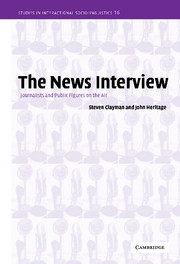Book contents
- Frontmatter
- Contents
- Acknowledgments
- 1 Introduction
- 2 The news interview in context: institutional background and historical development
- 3 Openings and closings
- 4 Basic ground rules: taking turns and “doing” news interview talk
- 5 Defensible questioning: neutralism, credibility, legitimacy
- 6 Adversarial questioning: setting agendas and exerting pressure
- 7 Answers and evasions
- 8 The panel interview: discussion and debate among interviewees
- 9 Conclusion
- Appendix: transcript symbols
- References
- Subject index
- Index of names
2 - The news interview in context: institutional background and historical development
Published online by Cambridge University Press: 23 November 2009
- Frontmatter
- Contents
- Acknowledgments
- 1 Introduction
- 2 The news interview in context: institutional background and historical development
- 3 Openings and closings
- 4 Basic ground rules: taking turns and “doing” news interview talk
- 5 Defensible questioning: neutralism, credibility, legitimacy
- 6 Adversarial questioning: setting agendas and exerting pressure
- 7 Answers and evasions
- 8 The panel interview: discussion and debate among interviewees
- 9 Conclusion
- Appendix: transcript symbols
- References
- Subject index
- Index of names
Summary
According to the Oxford English Dictionary, the term “interview” entered the language in 1514, from the French entre voir (meaning “to be in sight of”), hence referring to a “meeting of persons face-to-face, especially one sought or arranged for the purpose of formal conference at some point” (p. 1740). These first interviews were normally between high ranking individuals and, in a world where travel was difficult and most diplomatic communication was conducted by letter, they were rare events accompanied by high ceremony. The extraordinary 1520 extravaganza, when Henry VIII of England entertained Francis I of France so lavishly that the event (and its location) came to be known as the Field of the Cloth of Gold, may have been one of the first “interviews” ever to be so named.
By the end of the nineteenth century and the rise of modern journalism, the term interview came to have a different and more current meaning. Webster's dictionary of 1913 defined an interview as “a conversation, or questioning, for the purpose of eliciting information for publication,” noting that this is a “recent use, originating in American newspapers, but apparently becoming general” (Webster 1913:781). A more recent Webster notes that the term “interviewee” emerged in 1884. By this point, the term had lost its older ceremonial associations, and acquired its primary modern meaning as a journalistic practice.
Information
- Type
- Chapter
- Information
- The News InterviewJournalists and Public Figures on the Air, pp. 26 - 56Publisher: Cambridge University PressPrint publication year: 2002
